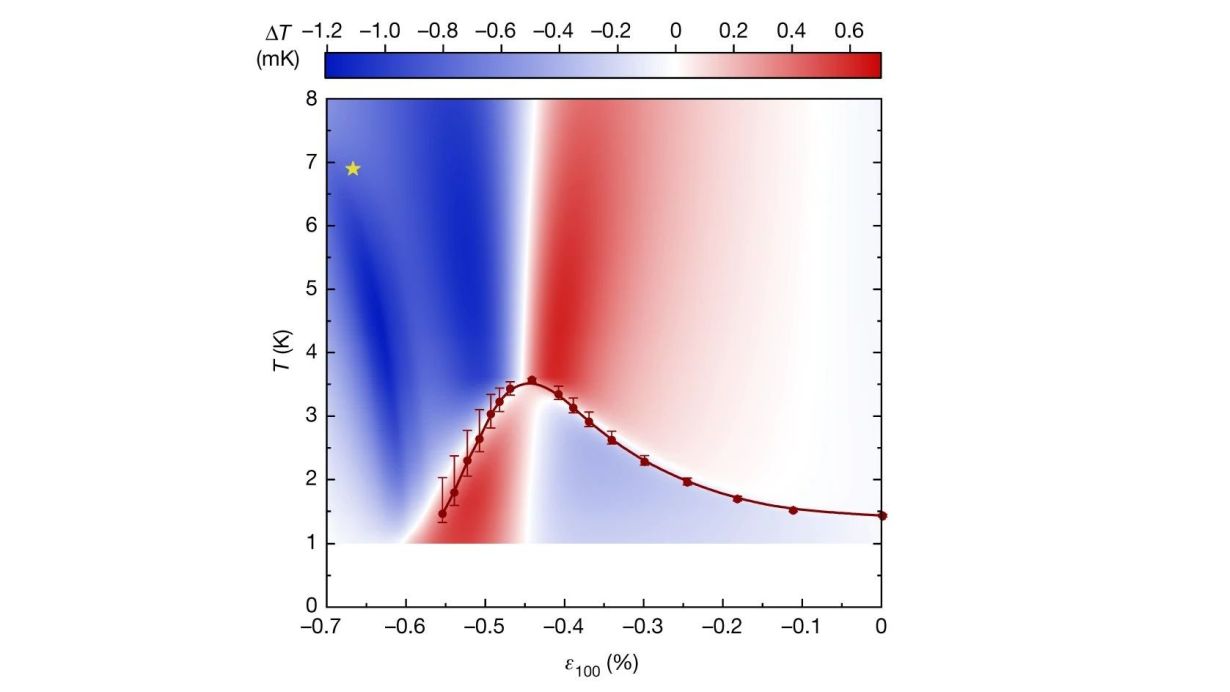Strontium ruthenate is a superconductor that gives rise to a number of questions. Researchers of Karlsruhe Institute of Technology (KIT) and Max Planck Institute for Chemical Physics of Solids (MPI CPfS), Dresden, have now found that mechanical pressure enhances superconductivity and, at the same time, facilitates deformation of the material. They attribute this to quantum mechanics excitations of the electrons. Their work contributes to understanding the interaction of elastic and electronic properties. The researchers report in Science (DOI 10.1126/science.adf3348).
Superconductors are materials that do not have any electrical resistance when the temperature is below a certain threshold, the so-called transition temperature. This makes them highly interesting for various applications in the areas of energy conversion and distribution. However, scientists have not yet understood why strontium ruthenate (Sr2RuO4) is superconductive. “Conventional theory cannot be applied to strontium ruthenate. But quantum mechanics helps, as it cannot only be used to describe the properties of single atoms and molecules. It also explains the collective properties of multi-particle systems,” says Professor Jörg Schmalian, Head of KIT’s Institute for Theoretical Condensed Matter Physics (TKM) and of the Theory of Quantum Materials Division of KIT’s Institute for Quantum Materials and Technologies (IQMT).
Mechanical Pressure in One Direction Increases the Transition Temperature
Schmalian is one of the main authors of the study published in Science. In 2022 already did researchers from several institutes of KIT and MPI CPfS publish an article in Nature. They reported that mechanical pressure in a certain direction considerably increased the transition temperature of strontium ruthenate and, as a result, changed the excitation behavior of electrons. In cooperation with international partners, the researchers from Karlsruhe and Dresden have now found that this pressure that increases superconductivity makes the materials much softer and facilitates deformation. The researchers attributed this to quantum mechanics resonance of the electron oscillations.
About 60 years ago, Soviet physicist Ilya M. Lifshitz predicted mechanical softening, which is known as Lifshitz transition today. “The effect observed now is a thousand times bigger and can be related to enhanced superconductivity. This is surprising, because less than 1 percent of the electrons existing in the material force the elastic constants to decrease by 20 percent,” Schmalian explains.
Effect Is Caused by a Few Current-carrying Electrons
The interaction of elastic and electronic properties also is in the focus of the DFG-funded Transregio project ELASTO-Q-MAT, in which MPI CPfS and KIT are the main project partners. For the study published in Science, KIT researchers developed a model of the effect that is caused by a few current-carrying electrons that soften the material. The corresponding measurements were made at MPI CPfS in Dresden. “Ilya M. Lifshitz’s theory is not wrong,” Schmalian points out. “But our study offers a new perspective and opens up the possibility to manipulate strong quantum fluctuations in the lab and to optimize materials for a certain physical effect.”
Original Publication
H. M. L. Noad, K. Ishida, Y.-S. Li, E. Gati, V. Stangier, N. Kikugawa, D. A. Sokolov, M. Nicklas, B. Kim, I. I. Mazin, M. Garst, J. Schmalian, A. P. Mackenzie, and C. W. Hicks: Giant lattice softening at a Lifshitz transition in Sr2RuO4. Science, 2023. DOI: 10.1126/science.adf3348
For the Abstract, click https://www.science.org/doi/10.1126/science.adf3348
More Information on ELASTO-Q-MAT
In close partnership with society, KIT develops solutions for urgent challenges – from climate change, energy transition and sustainable use of natural resources to artificial intelligence, sovereignty and an aging population. As The University in the Helmholtz Association, KIT unites scientific excellence from insight to application-driven research under one roof – and is thus in a unique position to drive this transformation. As a University of Excellence, KIT offers its more than 10,000 employees and 22,800 students outstanding opportunities to shape a sustainable and resilient future. KIT – Science for Impact.

